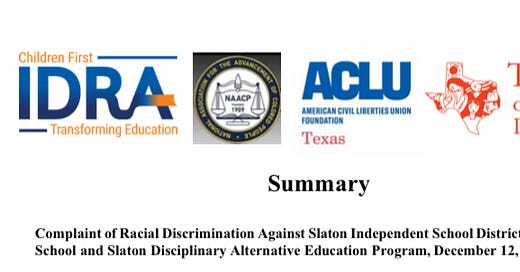Decoteau Irby, a researcher pursuing an equity agenda to pry loose the recalcitrant White Supremacist grip on public schooling in the United States, discussed five resources one suburban high school cultivated in its difficult equity reform effort:
Today’s headline reporting on Autumn Roberson-Manahan’s experience during her senior year this year at Slaton High School in Lubbock, Texas, makes visible the urgency of reform1. I’m referencing in the footnotes an article as well as the complaint filed yesterday by the ACLU:2
Autumn and her family moved to Lubbock, Texas, from Ohio, and were looking forward to a great school year. Autumn was on track to be valedictorian, having put together a solid academic track record at her previous school. But an unbridled, permitted, violent stream of anti-black ideology stored in the short historical memory of White Americans, unwoke and stoked, set back her academic progress. She ended up in the Slaton Disciplinary Alternative Education Program, one instantiation of a recurring Foucault’s nightmare.
In this case, Autumn and her family filed complaints with the school early in the year, trying to exercise an influential presence, the kind of action Irby calls a resource for equity, a tool available to all citizens. But the problem is more subtle. In Irby’s ethnography (2021), the data slice of a young Black student who arrives late to the cafeteria and gets turned away from lunch empty handed by a White worker has no opening to influence the scales of equity. In my own local community, a young and vibrant Black principal was recently suspended from her job for making White people uncomfortable. As I think about Irby’s five resources, I see how influential presence of Black and Brown students is a consequence of strengthening the other four.
Note that Autumn’s district, an independent district, sits next to Lubbock-Cooper district, which was put on notice of a lawsuit in the offing because parents of children at the Laura Bush Middle School complained about White students using racial slurs beginning with the letter N back in August. See the footnote3. Separate neighboring LEAs facing the same issue indicates a need for a more centralized and thoughtful response to pull back agency from the courts to the schools. Schools can do something to defang this rampaging hegemonic monster in our midst.
I can’t retrieve the media article from which I snapped the following screenshot, but it’s worth bringing in the following words. It might be the NBC piece. White willful myopia seeking to block anti-blackness from the center of organizational consciousness in schools is easy to spot in this clip. The question isn’t “which types of student behaviors are harmful” enough to deserve punishment as the article states, a relic of the Trump era. Educators aren’t in the business of punishment. The question is which student behaviors are courageous enough to warrant protection. The question is how do we teach young people to respect differences and seek understanding.
https://www.idra.org/wp-content/uploads/2022/12/Summary-Slaton-ISD-Complaint-of-Racial-Discrimination-121322.pdf
https://www.nbcnews.com/news/us-news/taunted-black-student-texas-civil-rights-complaint-rcna61172
https://radio.kttz.org/2022-08-31/lubbock-cooper-responds-to-racism-allegations-after-parents-hire-law-firm






NOTE: A link to the ACLU complaint is provided inside the NBC News article. The ACLU doc, a 3-page pdf, has a more detailed account of the extent and duration of the racial harassment Autumn and her two brothers endured.